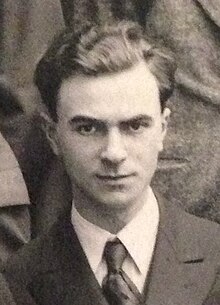C. E. Wynn-Williams
| C. E. Wynn-Williams | |
|---|---|

C. E. Wynn-Williams at the Cavendish Laboratory in 1927
|
|
| Born | 5 March 1903 'Glasfryn', Uplands, Swansea, Glamorganshire, Wales |
| Died | 30 August 1979 (aged 76) 'Bryn Elmen', Dôl-y-Bont, Dyfed, Wales |
| Nationality | Welsh |
| Fields | Physicist |
| Institutions | Imperial College, London, Telecommunications Research Establishment |
| Education | Grove Park School, Wrexham |
| Alma mater | University College of North Wales and Trinity College, Cambridge |
| Doctoral advisor | Ernest Rutherford |
| Notable awards | Duddell Medal and Prize (1957) |
| Spouse | Annie Eiluned James |
| Children | Gareth and Tudor |
Charles Eryl Wynn-Williams (5 March 1903 – 30 August 1979), was a Welsh physicist, noted for his research on electronic instrumentation for use in nuclear physics. His work on the scale-of-two counter contributed to the development of the modern computer.
Wynn-Williams was born at 'Glasfryn' in Swansea, Glamorganshire, Wales, on 5 March 1903. He was the eldest child of William Williams (1863–1945), a physics teacher and later divisional inspector of schools for north and mid-Wales, and Mary Ellen Wynn (1907–1935), known as Nell, daughter of Robert Wynn, a shopkeeper in Llanrwst. His education was at Grove Park School in Wrexham, and, from 1920, at Bangor University, where he graduated in 1923. He stayed on University to undertake research work on electrical instrumentation, and gained the degree of MSc from the University of Wales in 1924. He was known as C. E. Wynn-Williams from his time at University onwards.
Wynn-Williams was Liberal in politics and was a Welsh-speaker. On 12 August 1943 he married in London Annie Eiluned James (b. 1907/8), a school-teacher, with whom he would have two sons.
In October 1925 he entered Trinity College, Cambridge, having been awarded a University of Wales open fellowship. Initially he continued research into short electric waves at the Cavendish Laboratory under the supervision of Sir Ernest Rutherford, and was awarded the degree of PhD for this work in 1929.
Wynn-Williams' most significant work in this period, however, was in the development of electronic instrumentation for use in radioactivity and nuclear physics. Like many scientists at that time he was a wireless enthusiast.
In 1926 he employed his electronics skills to construct an amplifier using thermionic valves (vacuum tubes) for very small electrical currents. It was realized that such devices could be used in the detection and counting of Alpha particles in the nuclear disintegration experiments then being undertaken by Rutherford, who encouraged him to devote his attention to the construction of a reliable valve amplifier and methods of registering and counting particles.
...
Wikipedia
